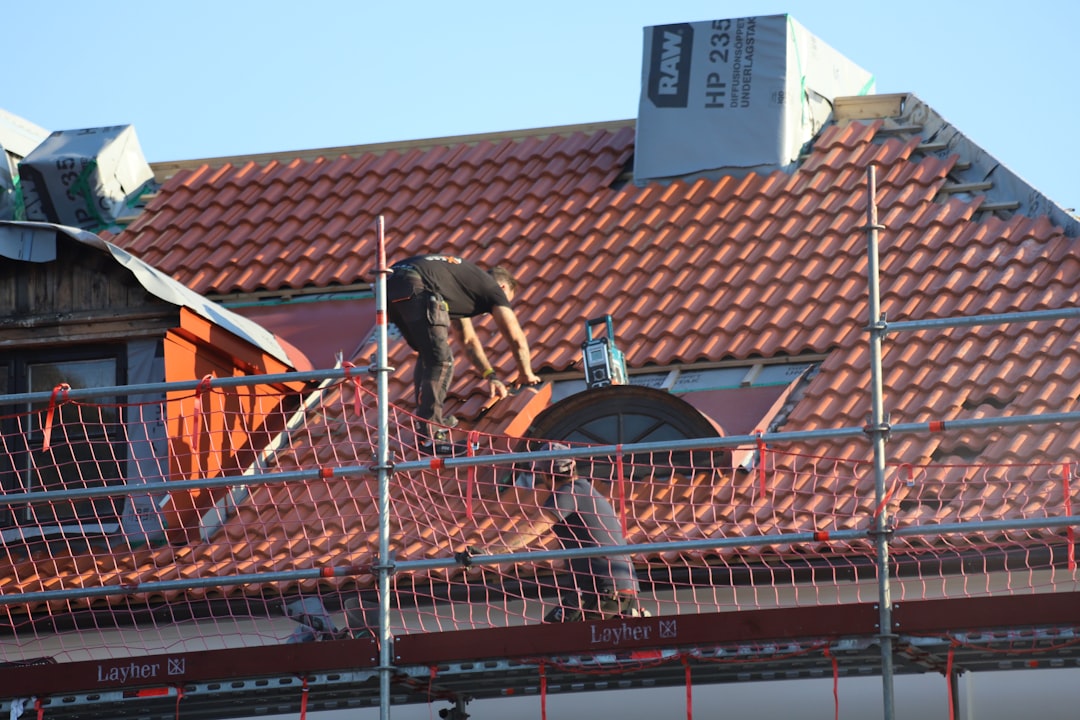

Engage prospects with a scan and streamline customer engagement with FREE QR code marketing tools by Sona – no strings attached!
Create a Free QR CodeFree consultation

No commitment

Engage prospects with a scan and streamline customer engagement with FREE QR code marketing tools by Sona – no strings attached!
Create a Free QR CodeFree consultation

No commitment
In today’s digitally driven landscape, the roofing contractors industry faces increasing pressure to connect traditional offline interactions with modern digital engagement. Many contractors share the frustration of high-value prospects slipping through the cracks, since analog touchpoints like door hangers, yard signs, and printed estimates rarely sync with a CRM or trigger timely follow-up. As competition intensifies and homeowner journeys become more complex, the inability to capture or attribute offline interest results in missed revenue and reduced marketing impact.
QR codes give roofing contractors a frictionless and highly effective way to translate physical presence into measurable leads and conversions. From yard signs and estimates to direct mail and smart tarps, QR codes provide instant access to reviews, appointment scheduling, service portfolios, storm updates, and warranty lookups, all without an app download. Every scan generates actionable insights that close visibility gaps and reduce lost opportunities.
This article equips marketing leaders and business owners with practical strategies to modernize processes, connect offline interactions to digital journeys, and maximize revenue. You will learn how QR codes solve common roofing pain points such as missed high-value prospects, anonymous traffic, and lost upsell moments while boosting engagement and conversion rates at every stage of the buyer journey.

Relying solely on handwritten forms or expecting homeowners to manually type a web address often results in lost leads, especially when people are distracted, in a rush, or hesitant to share information in person. QR codes bridge the gap between physical marketing like door hangers, business cards, and job site signage and digital actions such as form fills, estimates, or review submissions. For roofing contractors, the result is faster lead capture, a reduced risk of missing high-value prospects, and more reliable follow-up while homeowners are most engaged.
Replacing outdated processes with QR-enabled workflows has a direct impact on your pipeline. Printed brochures become interactive portals to video consultations and financing calculators. Paper sign-up sheets at home shows become mobile-optimized google forms. Job site signs transform into conversion engines that capture neighbor interest, attribute scans by location, and trigger instant callbacks for storm repair requests. The outcome is faster conversion, fewer manual data errors, and stronger attribution. And yes, Sona QR is built to support every step of this transformation: creation, management, tracking, and integration with your CRM.
Modern QR platforms let contractors create unique codes for each asset, location, or service line, then track and optimize performance in one place. You can update destinations without reprinting, attribute scans to campaigns, and A/B test calls to action that maximize conversion. This closes the loop between sight and action and unlocks opportunities to engage prospects who would otherwise remain anonymous.

The typical roofing journey stretches across offline and online moments. A homeowner might see your truck, glance at a yard sign, or pocket a flyer, then forget the details later or postpone action until the storm passes. Without a direct bridge from that moment of interest to an online conversion point, valuable leads remain unknown and unpursued. Marketing spend becomes hard to optimize because you cannot attribute which placements and messages actually drive demand, an area where multi-touch attribution provides clarity.
QR codes eliminate this disconnect. By placing them on direct mail, vehicle wraps, yard signage, invoices, and onsite documents, you enable one-scan actions that move prospects forward immediately. The homeowner who notices your truck can scan and request an inspection. The neighbor watching your crew can scan and view before-and-after photos, warranties, and reviews. The insurance-focused prospect can scan to access claim guidance and schedule an adjuster-friendly inspection. Every scan becomes a measurable signal, especially when you track assets like vehicles.
Imagine a QR code on an emergency services flyer that opens a short form with address auto-fill and photo upload. A homeowner scans, shares details, and schedules a call in minutes. Your team receives immediate notification, and the CRM tags the lead source and location. This tight loop increases conversions and provides clear performance data for smarter marketing decisions.

Selecting the right format for each interaction is essential. Roofing contractors often use a mix of materials: door hangers, job site signs, truck wraps, invoices, and showrooms. Each touchpoint benefits from a different QR code destination and experience. The objective is to connect scanners to the most relevant next step with as little friction as possible.
Dynamic codes are particularly valuable in roofing since offers, inspections, and storm response pages change frequently. With dynamic codes, you can update destinations, swap content, and A/B test calls to action while the same physical asset remains in the field. Static codes work for unchanging content like a general brochure PDF or a fixed phone number.
With a platform like Sona QR, you can generate all of these formats, manage them in one dashboard, and monitor performance across placements. You can also append UTM parameters for analytics, route scans by device, or personalize destinations based on campaign tags and neighborhoods.

Growth comes from placing QR codes where homeowners already see your brand and where their motivation to act is highest. Contractors often underinvest in attribution across physical media, which creates blind spots. By adding QR codes to high-visibility assets and aligning calls to action with context, you transform branding into pipeline.
Start with assets that already circulate in your market: yard signs on active jobs, door hangers after inspections, and truck wraps around neighborhoods. Then consider placements that reach homeowners during decision windows, such as storm season direct mail or invoices handed over after maintenance work. Always include a clear value proposition near the code, like Scan to book a free inspection or Scan to check warranty status.
For broader planning, see these roofing-focused resources: roofing marketing strategies and a local market blueprint.
With thoughtful placement strategies, each offline exposure becomes an opportunity to capture intent and attribute outcomes. Over time, scan data reveals which neighborhoods, messages, and media deliver the strongest return, guiding smarter allocation of budget.

Too often, lead capture processes are reactive. Contractors wait for calls or for homeowners to visit a website later, which delays engagement and increases the chance that a competitor responds first. QR codes turn passive interest into immediate action by giving people something useful to do in the moment they notice your brand.
Start by mapping common customer interactions: storm damage awareness, routine inspections, material selection, and post-project reviews. Then pair each moment with a QR-enabled action that reduces friction and proves value. The best use cases meet homeowners where they are and move them one step closer to a decision.
Modern solutions make every scan trackable. You can tie each engagement to specific assets and campaigns, then route leads to the right sales playbook. This improves conversion rates, aligns follow-up with buyer intent, and reveals the true impact of your physical marketing.
Not every scanned lead is equal. A homeowner scanning a yard sign at 8 p.m. during a hailstorm shows different urgency than someone browsing materials on a Saturday morning. Yet many contractors nurture every inquiry the same way, which dilutes impact and delays time-sensitive follow-up. With QR codes, you can automatically segment by intent, location, and context, then tailor your response.
Each scan event captures a signal: service interest, urgency, and likely budget. If you deploy unique codes for different service lines and placements, you can enrich contact records with behavioral data. From there, trigger retargeting with the right message, timing, and channel.
With Sona QR, each code becomes a smart entry point that builds your audience segments in real time. For additional tactics, see Sona’s Playbook intent-driven retargeting.
Disjointed marketing makes it hard to know what works. Roofing contractors often invest in print, out-of-home, and events without a clear view of which channels actually drive revenue. QR codes unify these efforts by connecting offline exposure to digital conversion, making measurement and optimization possible.
Think of QR codes as connectors that carry prospects from physical surfaces into your digital ecosystem. Once there, you can capture contact information, measure engagement, and trigger automated journeys. Over time, you learn where to double down: which messages resonate, which neighborhoods convert, and which assets deserve bigger budgets.
For quick inspiration, watch this short roofing marketing video.
QR codes serve as the offline onramp to your digital marketing engine. They also unlock a new layer of data collection across channels that were once difficult to measure. With a centralized platform like Sona QR, you can manage all your codes, monitor performance, and sync scan data with your CRM and ad platforms for closed-loop attribution.
Your QR strategy works best when it follows a clear plan. The steps below guide you from idea to attribution so you can launch quickly, learn fast, and scale what works. Tailor each step to your service mix, seasonality, and regional market conditions.
Before you begin, define what success looks like. For roofing, that might be increasing inspection bookings during storm season, accelerating reviews after completion, or generating more neighbor referrals from active job sites. Set measurable targets, then deploy codes that make the next step effortless.
Start with a single, high-impact objective. If your area has a major hail season, prioritize storm response bookings. If you need more social proof, focus on post-project review capture.
Choose between static and dynamic. Static codes are fine for unchanging destinations like a general brochure. Dynamic codes let you track scans, edit links, and segment audiences without reprinting.
Design influences scan rates. Brand the code, add a frame, and pair it with a bold headline that explains the value. Ensure the code size, contrast, and placement support quick scanning.
Roll out codes on assets your audience already sees. Start with a few placements per use case so you can compare performance, then expand.
Measurement is the difference between guessing and growing. Use analytics to monitor activity, then iterate on design and messaging for higher conversion.
Roofing contractors often struggle to connect print and offline activities to closed deals. Without attribution, it is difficult to prove campaign effectiveness, justify spending, or prioritize initiatives. Since buying journeys frequently span multiple touches, you need tools that link scans to downstream outcomes—start with offline attribution.
Effective QR tracking attributes every scan to a specific asset, campaign, or journey stage. By tagging codes with UTM parameters and syncing with your CRM, you can see how scans translate into appointments, estimates, and jobs won. Over time, this data informs smarter budget allocation, more targeted creative, and higher ROI.
With Sona QR and Sona, you can operationalize this end to end. Sona is an AI-powered marketing platform that turns first-party data into revenue through automated attribution, data activation, and workflow orchestration.
The result is a closed-loop system in which every scan becomes a measurable step toward revenue. Sona QR captures real-world engagement and Sona turns that engagement into actionable insights for performance marketing.
QR success scales when you treat each code like a campaign with a goal, a message, and a measurement plan. Create unique codes per asset and service line, then monitor performance and iterate. Train crews to point out QR-enabled materials and explain what homeowners receive after scanning, such as a faster estimate or an easier warranty lookup.
Focus on tips that align with common roofing media and buyer journeys. For storm-heavy markets, emphasize emergency booking and insurance guidance. For competitive retail markets, highlight material comparisons, financing pre-approval, and neighbor referral offers.
Roofing contractors who adopt QR codes set a new benchmark for marketing efficiency and customer experience. By connecting physical assets with data-driven digital journeys, you gain visibility into buyer interest, streamline outreach, and open new avenues for growth and loyalty. As competition increases, those who put QR strategies at the center of their marketing will capture more leads, prove performance, and continuously improve revenue in today’s evolving roofing market. Start creating QR codes for free.
QR codes have transformed roofing contractors’ marketing and customer engagement from static, one-way communication into powerful, measurable growth drivers. Whether it’s streamlining access to project details, simplifying appointment scheduling, or providing instant estimates, QR codes replace outdated processes with seamless, mobile-friendly interactions that enhance customer trust and accelerate decision-making. Imagine instantly connecting homeowners to your services with a simple scan—no more missed calls or lost leads.
With Sona QR, roofing contractors can create dynamic, trackable QR codes in seconds, update campaign content without reprinting materials, and link every scan directly to real-time insights and revenue. This means you can optimize marketing efforts, improve customer experience, and grow your client base with confidence and ease. Start for free with Sona QR today and turn every scan into a new opportunity for your roofing business.
QR codes connect offline marketing materials like yard signs and door hangers to digital actions such as appointment scheduling and review submissions, enabling faster lead capture, better attribution, and higher conversion rates.
QR codes provide measurable leads, reduce lost opportunities, enable dynamic updates without reprinting, build trust with instant access to reviews and warranties, and improve marketing attribution across physical and digital channels.
Roofing companies place unique QR codes on assets such as door hangers, smart tarps, and truck wraps that direct homeowners to booking forms, warranty information, or service portfolios, capturing lead data instantly and triggering timely follow-up.
While the article does not specify the exact market value, QR codes contribute by transforming physical marketing into measurable digital engagement that increases lead capture, improves conversion rates, and drives revenue growth in the competitive roofing industry.
Smart tarps embed QR codes that give homeowners and neighbors instant access to warranty details, emergency repair requests, and project galleries, increasing engagement and generating leads directly from job sites.
Use Sona QR's trackable codes to improve customer acquisition and engagement today.
Create Your FREE Trackable QR Code in SecondsJoin results-focused teams combining Sona Platform automation with advanced Google Ads strategies to scale lead generation

Connect your existing CRM

Free Account Enrichment

No setup fees
No commitment required

Free consultation

Get a custom Google Ads roadmap for your business






Launch campaigns that generate qualified leads in 30 days or less.
